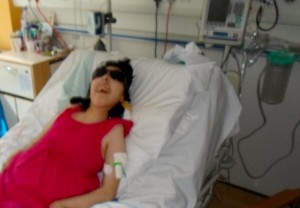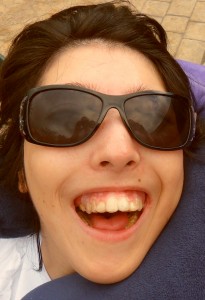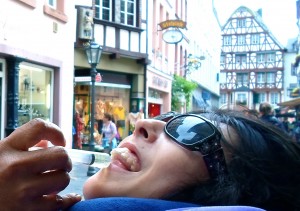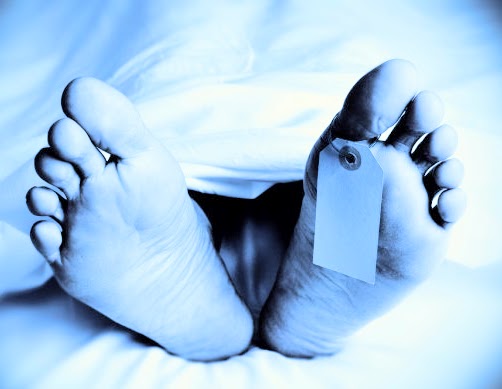We have the best healthcare in the world, so we are told, free at the point of use. So why would there be any dangers facing the disabled in hospitals as they enter for healthcare? Well, perhaps British healthcare was once the best in the world but it most certainly is not now. Our Camille’s life and death in 2013 illustrates the many and varied dangers facing the disabled in hospital. From negligent mistreatment, arrogant and mistaken prognoses, lethal and incentivised death pathways, unjustifiable lack of communication, to perverse requests for organs which further incentivise the mistreatment of a disabled patient the risks are horrifying. As a family, we are still reeling at what happened to our daughter.
Camille Maryse McClymont, was a 22 year-old young lady with complex medical needs. She had severe cerebral palsy, was quadriplegic, blind and with no gag reflex. Camille was our beloved daughter. Although disabled, she was highly intelligent, understood two languages and inspired those who knew her. She had two establishments in her name, Camille’s Nest in Cornwall, and La Maison de Camille, near Bordeaux. Despite her limitations, at the time of her death, she was in the process, albeit with some assistance, of writing a book, due for publication in 2015. There were things that she felt doctors needed to know that they clearly did not grasp.
From the time of her birth, her life was complex and eventful in ways that most people could not comprehend, never mind endure. All of these events had to be overcome in order for her to survive and we succeeded very well with this over the years. However, in March of 2013, Camille was admitted to Derriford Hospital in Plymouth with a series of fits. We pointed out that this seemed to be triggered by a recurrent untreated abdominal problem.
At the time, this information was ignored and Phenytoin was prescribed which controlled the fits. With the fits under control, she went home, but the underlying problem that was the cause of the fits was still not dealt with. We didn’t have Phenytoin at home, so when it wore off, the fits returned and she went back into Derriford Hospital. By now her condition had worsened. The following afternoon we were informed that she would not last out the day as she had necrosis of the colon and severe pancreatitis. She was too unfit to withstand the necessary operation and without it, she would die. This turned out to be false. It was not necrosed. A week later we were informed that she had severe necrotic pancreatitis and could not survive more than a few hours. I told the consultant that in the course of the average year we go through several crises and she always recovers. “Not this time,” he said glibly. I was so stunned I could not reply but wondered how he could be so sure. I was soon to find out.
Liverpool Care Pathway
Without our knowledge or consent, one Saturday night she was put on the now defunct Liverpool Care Pathway “in her best interests”. Because she was deemed to be dying, a series of procedures designed to sedate, medicate and dehydrate her was triggered. The sedation can reduce a patient’s respiration we are told. All fluids and regular prescribed medication were stopped, the drip taken down and oxygen removed. The nurse assured us, “She won’t need it now.” The truth was that thanks to challenges on our part, we were able to remove our daughter from the Pathway, remove her from the hospital and actually save her life. After that we were able to spend valuable months with her both on holiday on the Continent and in the UK.
When confronted by us about the implementation of the lethal regime, the doctors reversed the LCP. In the next week, fifteen different doctors asked variants of the same question. What is the quality of her life? Eventually you begin to question the question behind the question, the answer of which, as we shall see, was revealed later.
Importantly, had we not intervened to get Camille off the Pathway, she would have died a cruel death by dehydration many months before she did eventually die. Put simply, Camille was not dying when she was placed on the Liverpool Care Pathway, but would have done had we not intervened with a catalogue of questions and demands. She came home with us and we went on holiday abroad. These were deeply important months for us but for those asking the Pathway question, they were a costly irrelevance.
This is just one of the lethal dangers for the disabled in modern Britain. The Liverpool Care Pathway, it should be understood, is commonly known in Britain as the Death Pathway, and not without good reason, as revealed by Professor Patrick Pullicino and Dr Jacqueline Laing, two people we have much to thank for their part in the subsequent revelations. It became apparent in 2012 that the sedation and dehydration regime had been financially incentivised with hospitals, hospices and care homes being paid millions of pounds to achieve a high level of implementation by target setting. Derriford Hospital on their website in April 2013 said that a third of patients who died in their hospital did so on LCP. If you remove violent deaths and traffic accidents etc from their total, the percentage of LCP deaths would be considerably higher.
Professor John Ellershaw, creator of the Pathway and director of the Marie Curie Palliative Care Institute in Liverpool and Deborah Murphy, its associate director, defended the Pathway with assurances that the “sole purpose of the LCP is to provide the best possible care for people in the last days or hours of their life… [providing] good care, compassion and communication.”
“Good care, compassion and communication”! None of these existed in Camille’s case. Killing the patient in her “best interest” is not compassion, most particularly I must stress, when she is not dying in the first place! She may have been disabled but she was still our precious daughter. Efforts to sedate and dehydrate her to death were foiled but only because we had the presence of mind and courage to challenge her treatment. I still wonder about those poor families that accept the prognoses of the medics and cooperate with their lethal programmes.
Professor Ellershaw and Ms Murphy argue that “[t]he provision or withdrawal of interventions with the direct aim of hastening death is contrary to the rationale of the LCP, contrary to GMC (General Medical Council) guidance, and illegal.” This all sounds very good.
How does this relate to Camille’s case then? According to the General Medical Council guidance, the hospital, by putting Camille on the sedation and dehydration pathway, was not acting illegally and committed no criminal offence. This was because they had already decided that she was dying and on the Pathway. If you ask me, it was not a mistake and not an accident, but a concerted, orchestrated deliberate action involving many people in a process to end her life and thus was a crime in any terms. In short, it would have been murder by any other name. So why then, because it is done by doctors is it regarded as a sophisticated care plan, done in secrecy in the “patient’s best interest”?
 That being the case, do these medical professionals and managers not know or understand what they are doing? Are they so blind, stupid or ignorant? I think not. I believe it is a case of arrogance in the extreme. They believe the patients and their families are too dumb to know better, too stupid to see through it and too impotent to do anything about it. Their disdain for the patients and their families is palpable. Families are quickly made aware that they are not bigger than the doctor, his department, the hospital and their legal department. They are not bigger than the Trust, the Regional Health Board, the NHS itself and its massive public relations machine, the GMC, the Medical Defence Union. The family will be burdened by bureaucracy, doublespeak and form filling, all at a time when they are trying to just get information and deal with their family grief and are at their most fragile and vulnerable.
That being the case, do these medical professionals and managers not know or understand what they are doing? Are they so blind, stupid or ignorant? I think not. I believe it is a case of arrogance in the extreme. They believe the patients and their families are too dumb to know better, too stupid to see through it and too impotent to do anything about it. Their disdain for the patients and their families is palpable. Families are quickly made aware that they are not bigger than the doctor, his department, the hospital and their legal department. They are not bigger than the Trust, the Regional Health Board, the NHS itself and its massive public relations machine, the GMC, the Medical Defence Union. The family will be burdened by bureaucracy, doublespeak and form filling, all at a time when they are trying to just get information and deal with their family grief and are at their most fragile and vulnerable.
The report went on to say, “While Professor Ellershaw and Ms Murphy are the main architects of the LCP, responsibility for day-to-day implementation lies with individual hospitals, GPs and care homes.” That’s okay then! Messrs Ellershaw & Murphy can sit back and reflect in their good work and blame others for poor implementation. It is good to know that they have such a caring attitude. When the whole thing goes horrifyingly wrong, which the LCP has done for hundreds of thousands of people who, unlike us, will simply wonder whether their loved one was killed unnecessarily by the procedure, the architects deny all reponsibility for its catastrophic implementation. Perhaps Messrs Ellershaw & Murphy could come up with some more ‘good ideas’ and direct their collective brilliance and common human decency on how to get the genie back in the bottle instead of human remains into urns.
The trouble with the LCP is that, as concerned medical professionals have noted, it is impossible to tell with any certainty whether a patient is imminently dying and our Camille was certainly not dying. This point was made absolutely plain when some months later they again turned off her ventilator expecting her to die. She went on to breathe by herself and live at home with us safe in the company of her own family and away from those who believed that she had no best interests save those enjoyed by a swift medically induced death! Ironically, this was at a point in her life when she was at her best apart from the recurring still untreated abdominal problem.
Negligent Mistreatment
Which brings us to another danger facing the disabled in hospital. After getting Camille off the Death Pathway, we were told the cause of the pancreatitis was gallstones and her gallbladder had to be removed. This was also thoroughly false as identified in the operation notes when a perfectly healthy gallbladder was removed. This was after another consultant had informed us that the pancreatitis was caused as a side effect of the Phenytoin that was earlier prescribed for the fits. This they had prescribed instead of dealing with the real problem in her colon that they were so busy ignoring, but referred to in the same notes of the same operation. They had the opportunity then to look like the good guys and put their hands up and say, “Look! We’ve found the real problem, it isn’t what we thought. It’s this!” But no! They were too arrogant for that. They also regarded us as too stupid to know better. As long as they all stuck together, thick as thieves, how would we know? One of their colleagues had pre-empted them earlier by rightly telling us, “One doctor won’t shop another doctor.” So now, they were in too deep and the LCP had backfired on them. We took Camille home, still with no knowledge of the real cause of her pain until, that is, we saw the death certificate and the operation notes after she died. All this negligence and cover-up is yet another danger facing the disabled in hospital.
Organ harvesting after negligent mistreatment.
But negligence, arrogant cover-up and death pathways are not the only dangers in store for the disabled in hospital. In August, Camille again was ill with the same untreated abdominal pain, and yet again she was admitted to Derriford Hospital. By now her condition deteriorated further as the underlying cause was still untreated. We were now told she had shingles and viral septicaemia. After a couple of weeks, she was now unconscious and admitted to ITU in what we were told was a persistent vegetative state. An ominous feeling of déjà vu came over us. A doctor informed us that hard decisions would have to be made, though not immediately, but certainly within a few days but didn’t say what they were. We were about to find out what they would be.
A peculiar rigmarole ensued whereby a series of daily meetings took place. Each day a different doctor with a corroborating witness, who never spoke, would conduct the same routine. They said, as they didn’t know Camille, could we tell them what we understand about her situation? How did we see it? There was a point to this daily routine, but no one offered to enlighten us. You could see they were desperate for something but would never say what or get to the point. Each meeting fizzled out to be repeated the next day. It was a wearing down process. The medical staff, to all intents and purposes, regarded Camille as already dead, but we knew better. I could feel the tension and frustration mounting and eventually after five days one consultant had had enough and came to the crux of the matter. This time, about ten doctors, nurses and assorted personnel were crammed into a room the size of a small toilet. This time they meant business, whatever it was, as they say in the vernacular, they were mob handed.
The consultant sat in a particularly patronising chummy way. He said, “Normally in these situations, parents eventually realise that there’s no hope and discuss organ donation.” He paused just long enough for us to believe what he had just said, but before we could respond, he continued. “Have you considered this? We could have a surgical team on standby to harvest her organs.”
Then the penny dropped. So that’s what it’s all about! Harvesting her organs. Like some old clapped out car down the knackers yard, cannibalising bits from her. She was more valuable dead than alive! Commoditised yet again! So! This was the question behind the question. After LCP, she wouldn’t have needed her body parts, so they would have them. We were aghast! They didn’t get them the last time, but here they were back for another go. This was not only surreal, but these people we totally relied on and trusted were unreal!
It was impossible to answer his question, so I pointed out that this required a family discussion though I knew how everyone would respond. The consultant’s face darkened and his demeanour stiffened in his seat as he wanted a different answer. He sat back and tried a different tack implying that even if she could not live on, her organs could in someone else. Do we get visiting rights? Were we supposed to go and visit her organs at weekends and Christmas or something? This situation was grossly insulting to Camille’s dignity, to our intelligence as caring parents and to the principles of medical ethics. Are these people sane? Given that they had got their LCP prognosis so wrong how could they be so arrogant yet again? “What could you use if she’s got viral septicaemia?” asked Dolly, my wife. The consultant looked straight through her. “Plenty!” was the answer.
Ventilator removal and organ harvesting
A decision was made anyway that the ventilator would be switched off. A time was set for next day at one o’clock. Just like that, heartless, like visiting the dentist or taking your car for an MOT. But this was our daughter’s life coming to an end, appointed arbitrarily at one o’clock tomorrow. She is a person, our dearly loved daughter being treated like an old car bound for the knacker’s yard. Twenty odd years of her defying the odds and us intervening for her to survive despite doctors’ efforts, rather than because of them, means nothing to some people. Camille’s life was to be terminated at the throw of a switch, like turning off the lights.
On the matter of harvesting the organs and having a surgical team on standby, that was only part of it. It is really two teams, one for the donor and one for the recipient. Perhaps people need to think deeper about the actual process on donating their organs and how they are harvested along with tissue and bone and whatever else has value. If you are dead, actually, heart stopped beating and going cold, your organs are not much good to anyone if the tissue is already decaying. They need them fresh, straight off the ventilator, or at least from the ward to the operating theatre as quickly as possible and back onto another ventilator to keep them oxygenated to prevent the tissue from dying. Next door in another theatre, the recipient will be prepared. When the doctor is telling you that your relative is dead make sure you have the clarification of them being “brain dead”, “cardiac dead” or stone cold dead. A little research will reveal to you the differences as organ donation and tissue donation is becoming a major lucrative global industry. Of course, with Camille, we were naïve like anyone else and still believed that doctors were working for us trying to save her and other anonymous recipients.
When we arrived the next day at the appointed time I ran the gauntlet of different staff asking the same question. “Have you decided about the organs?” Each time I made the same reply, “Yes! She still needs them.” There was now a subtle shift in emphasis from “her” organs to “the” organs, as if they were already not hers.
 After nine days in intensive care the ventilator was turned off. We waited for the inevitable. Doctors waited for her organs, but again, we declined. Just before one o’clock about twenty people crammed into the side room in ITU for the ventilator to be disconnected. The family and her team would not leave her. We all wanted to be with her till the end and all sniffled as the priest gave the last rites. After nine days in intensive care, this was it, the final moment. The ventilator was turned off. A strange silence hung in the air. All eyes were on Camille with the anticipation of her soul exiting her body and wisping its way upwards towards heaven in front of them. We waited uneasily for the inevitable. The doctors waited for her organs, but again, were disappointed. Camille didn’t stop breathing as expected after the ventilator removal. As I said earlier, predicting when a person is going to die is far from plain if it is a natural death. Of course, predicting the moment of death is easy if one causes it. So, next day, as Camille was still breathing and nothing had changed, we took her home. She still needed her organs. As another doctor later said, “These men are not stupid, they know exactly what they are doing. They have an agenda to follow.” Two and a half weeks later, she died peacefully in her own bed, in her own room, surrounded by her favourite things and favourite people, in her treasured home, Camille’s Nest.
After nine days in intensive care the ventilator was turned off. We waited for the inevitable. Doctors waited for her organs, but again, we declined. Just before one o’clock about twenty people crammed into the side room in ITU for the ventilator to be disconnected. The family and her team would not leave her. We all wanted to be with her till the end and all sniffled as the priest gave the last rites. After nine days in intensive care, this was it, the final moment. The ventilator was turned off. A strange silence hung in the air. All eyes were on Camille with the anticipation of her soul exiting her body and wisping its way upwards towards heaven in front of them. We waited uneasily for the inevitable. The doctors waited for her organs, but again, were disappointed. Camille didn’t stop breathing as expected after the ventilator removal. As I said earlier, predicting when a person is going to die is far from plain if it is a natural death. Of course, predicting the moment of death is easy if one causes it. So, next day, as Camille was still breathing and nothing had changed, we took her home. She still needed her organs. As another doctor later said, “These men are not stupid, they know exactly what they are doing. They have an agenda to follow.” Two and a half weeks later, she died peacefully in her own bed, in her own room, surrounded by her favourite things and favourite people, in her treasured home, Camille’s Nest.
Conclusion
What then are the dangers facing the disabled in hospital? At a time when the disabled are said to have rights, nothing could be further from the truth once they enter a hospital. They are faced with lethal mistreatment created by incentivised target setting and plain old negligence. They and their families are faced with arrogance and gross lack of communication. They are faced with mistreatment and cover up. And they are introduced to the question of organ harvesting which, in conjunction with bed clearing targets, operate to ensure that the disabled may well be regarded as more valuable dead than alive. In this medical environment is it surprising that there is little honesty, integrity and common human decency in the practice of medicine? On so many occasions (too many to mention here) our intervention saved Camille from certain death. This was particularly obvious when she was put on the Liverpool Care Pathway and, after being saved from that lethal programme, went on to holiday with us in Germany.
The dangers come in various forms, like wolves in sheep’s clothing, flattering to deceive with promises that all is well. Beware! The medical agenda might not be your agenda. Too many doctors and hospital managers forget that they are just people. One day they might find themselves or their families being visited by their karmic targets. I wonder, would they recommend the treatment that Camille had for their twenty two year old daughter?








Comments